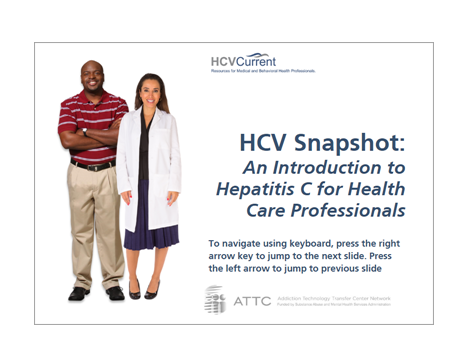
HCV RNA Provider Card (PDF)
Hepatitis C Infographic and Initiative Overview (PDF)
Motivational Interviewing to Address Hepatitis C - Vignettes (Link)
Click Here to Download an Overview of the HCV Current Initiative.
HCV Current is funded by the Substance Abuse and Mental Health Services Administration (SAMHSA).
An estimated 2.4 million Americans are living with hepatitis C (HCV). Many people who have HCV do not know they have it. Certain factors, such as injection drug use, can increase a person’s risk for HCV. In March 2020, the U.S. Preventive Services Task Force published a final recommendation statement recommending that clinicians screen all adults aged 18-79 years for HCV.
HCV rates increased 71% from 2014-2018. Two-thirds of new cases occurred in people 20-39 years old, the age group most impacted by the opioid epidemic. Unsafe injection drug use is cited as a major contributor to this increase in HCV infections. (National Viral Hepatitis Plan 2021-2025).
The ATTC Network offers multiple training options, including:
This 6-hour face-to-face training curriculum was recently updated in 2019 and includes the latest in treatment options available and the impact of the opioid epidemic on HCV in the U.S. The course is designed to instruct behavioral health and medical providers on hepatitis C (HCV) epidemiology, opportunities for promoting HCV screening and testing, treatment options and considerations, and linking persons infected to HCV health care.
By the end of this training, participants should be able to:
Request a Hepatitis C training by contacting the ATTC in your region.
SAMHSA's TIP #53: Addressing Viral Hepatitis in People with Substance Use Disorders (PDF)
Viral Hepatitis National Strategic Plan: A Roadmap to Elimination for the United States (2021-2025) (PDF)
Viral Hepatitis Prevention Coordinators (Link)
Last Updated July 29, 2020